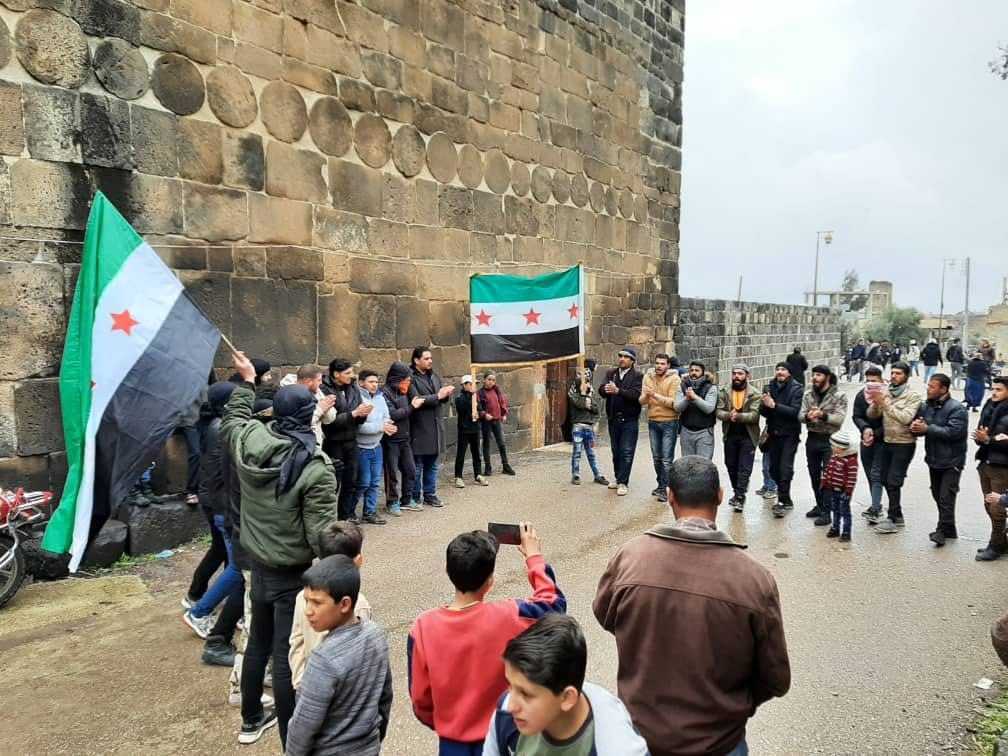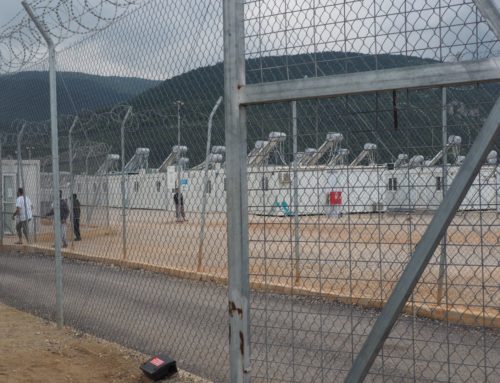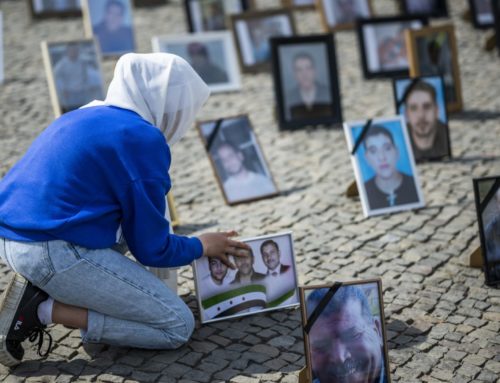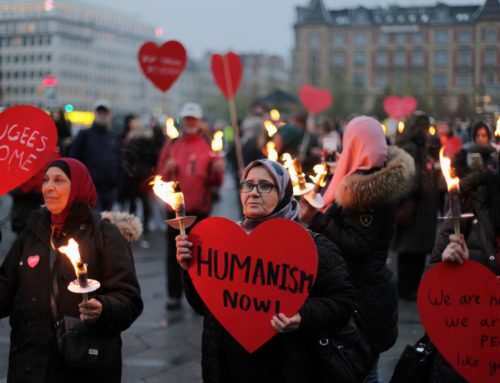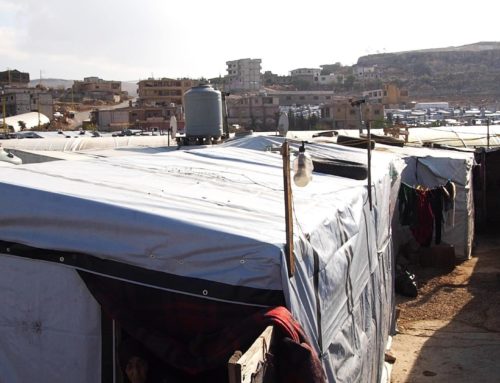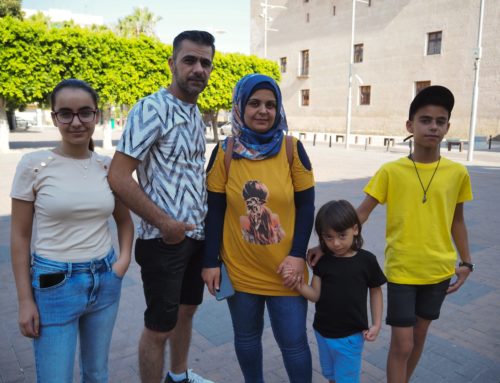On the 11th anniversary of the revolution, Syria is no place to return to
Despite international talk of “voluntary return” for Syrians, deteriorating security, economic, and living conditions give them little to go home to, eleven years after the revolution began.
19 March 2022
PARIS — Since mid-March, Syrians have been commemorating the eleventh anniversary of the Syrian revolution in different parts of the country. Most recently, dozens of people came out in anti-regime protests in Syria’s southern Daraa province on March 18, despite the area being back under state control since summer 2018.
Demonstrators in the Houran, as Daraa is also referred to, renewed their demands for the “fall of the regime” and the release of detainees. The protests are one indication that neither recent settlements and the security reality imposed by Damascus on the “cradle of the revolution” nor the chaos it has contributed to have severed the province’s connection with its revolutionary history.
Eleven years after demonstrations against Bashar al-Assad’s government began, much of Syria’s infrastructure is destroyed, and economic and living conditions are deteriorating. The number of people in need of humanitarian support and protection in the country has reached 13.4 million, 6.7 million of whom are displaced, according to UNHCR. And yet, international talk of Syrian refugees returning to their country is on the rise.
In early March, Turkish Foreign Minister Mevlüt Çavuşoğlu stated in a press conference that his country is working with Jordan for the voluntary return of Syrian refugees to their country, adding that his country hoped to organize a ministerial conference to discuss this objective.
In Denmark, Syrians are continuing to fight a legal battle against Copenhagen’s policy that considers Damascus and Reef Dimashq safe areas for Syrian refugees to return to. There are also concerns this policy could be extended to include Tartus and Latakia.
All this poses the question, once more, of whether it is possible for Syrians to return to their country, given the latest security, service and economic conditions.
Safe return
Ten years after arriving in northern Jordan’s Zaatari camp, Nour al-Mahmoud (a pseudonym), 31, still resists the idea of returning to Syria. She considers the country “unsafe because of the presence of the regime,” whose forces killed her brother in mid-2012 in front of their house in Daraa al-Balad, the southern portion of Daraa city, then detained her father for several weeks before they left the country, she told Syria Direct.
On the 11th anniversary of the revolution—largely marked on March 15 while March 18 is the date street demonstrations began in Daraa—the Syrian Network for Human Rights (SNHR) issued a report on the toll of violations in Syria since mid-March 2011. In that time, 228,647 people have been killed, including 14,664 under torture, while 151,462 were subjected to enforced disappearance.
Last year, Human Rights Watch documented cases of arbitrary arrests, torture, and extrajudicial killings among Syrian refugees who returned from Lebanon and Jordan.
Al-Mahmoud fears that “the situation could blow up at any time, as happened months ago in Daraa al-Balad,” where the regime imposed a siege from June to July 2021, accompanied by a large-scale military campaign to storm the encircled neighborhoods that lasted for weeks. The campaign ended with the signing of a new settlement agreement in September 2021, under which former opposition fighters were forced to turn over their individual weapons.
Daraa is experiencing rampant insecurity, with continued assassinations of civilians as well as those affiliated with parties to the conflict, as well as kidnappings that target civilians, including children.
So rather than returning, some citizens are leaving. Last October, journalist Habib Kasabrah decided to leave his home in Daraa province with his wife and children. They were smuggled into a neighboring country “after I received death threats from officers in the regime forces and Lebanese Hezbollah,” he said.
“The area isn’t safe, and it won’t be, with the presence of a repressive, tyrannical regime and the militias allied with it,” Kasabrah added.
Although four years have passed since the regime took control over the “de-escalation zones” established through the Astana talks sponsored by Russia, Turkey and Iran, Damascus continues to carry out new settlements there, as well as in Raqqa and Deir e-Zor, in an attempt to consolidate its presence.
Recent settlements across the country are aimed at defectors from regime forces and security forces, so long as they immediately join their military units, as well as those who have not completed compulsory military and reserve service. In exchange, the regime cancels the search bulletins issued for those who are wanted, and is set to remove their names from military checkpoints by the end of April.
Areas of northeastern Syria controlled by the Syrian Democratic Forces (SDF) are also seeing insecurity and military operations against Islamic State (IS) cells. The latter launched an attack on al-Sinaa prison in Hasakah city on January 20, the largest such attack since the organization’s 2019 defeat.
In northwestern Syria, which is controlled by Hay’at Tahrir al-Sham (HTS) and Syrian opposition factions, Syrian regime forces and affiliated militias have continuously violated a March 2020 ceasefire agreed between Turkey and Russia.
Services situation
Nine years after the regime took control of the old neighborhoods of Homs city, the area still suffers from “poor services, and entirely destroyed neighborhoods,” said Nour al-Homsi (a pseudonym).
Al-Homsi, 28, is originally from the Bab al-Dreib neighborhood of Homs, which she fled in March 2013 after clashes between the Free Syrian Army and the regime “grew close to our house, and all aspects of life, including education, had stopped” she said.
The central Syrian city is now “somewhat safe,” said Homsi from her current residence in Amman, Jordan. But “going back is impossible at present,” she said, due to the destruction of the city and poor services there.” Al-Homsi’s house has been “bombed several times, which partially destroyed the roof and walls,” she said.
In 2019, the United Nations Institute for Training and Research (UNITAR) published a set of maps showing the extent of destruction to Syrian provinces and cities over the past years, based on an analysis of satellite images.
The UNITAR assessment found that Aleppo province saw the largest percentage of destruction in Syria, with 4,773 buildings completely destroyed, 14,680 severely damaged and 16,269 moderately damaged. In Raqqa province, 3,326 buildings were destroyed, 3,952 were severely damaged and 5,493 were moderately damaged. Homs province saw 3,082 buildings destroyed, while 5,750 were severely damaged and 4,946 were moderately damaged. And in East Ghouta, in Reef Dimashq, 9,353 buildings were destroyed, 13,661 were severely damaged and 11,122 were moderately damaged.
Given the scale of the destruction and the Damascus government’s inability to repair and rehabilitate infrastructure, civilians in southern Syria sometimes rely on community initiatives to repair schools or service centers. Similar initiatives have been implemented to confront the COVID-19 pandemic.
Meanwhile, the question of Syria’s reconstruction is still pending, with the United States and European countries stressing the need for a “political solution” as a prerequisite for reconstruction. These countries also continue to impose economic sanctions on the Syrian regime and its political, military, and economic figures.
Stratfor, an American consultancy specialized in security and intelligence studies, estimates the bill for reconstruction in Syria at about $500 billion, or more than eight times the country’s pre-war GDP of $60 billion in 2010.
Economic hardship
“Don’t come back–we’re barely staying alive,” is the advice that Muhammad al-Hamadi’s mother, who lives in the northwestern Daraa city of Jasem, gives him every time he calls her from Jordan, where he has been since 2013, he told Syria Direct.
She often cries, missing her son and grandchildren “who were born far from her, and who she hasn’t seen until today,” al-Hamadi said. “But she prefers for us to stay outside of Syria, because of the deteriorating economic and security situation.”
Al-Hamadi said he sends $100 a month, or around 71 Jordanian dinars (JOD), out of his JOD 500 salary to his parents to “reduce the burdens” on them, but “this amount is not enough for them to live a decent life.”
Since the Syrian revolution broke out in March 2011, the value of the Syrian pound against the dollar has fallen from SYP 47 to SYP 3,850, according to the current parallel market exchange rate.
Amid deteriorating economic conditions, the Damascus government earlier this year excluded some 600,000 families from a package of state subsidies on basic goods and services. The circle of those excluded from subsidies could expand still further, economic researcher Manaf Kuman recently told Syria Direct.
Eleven years on from the revolution, Syrians, particularly in regime-held areas, lack “the most basic necessities,” said journalist Kasabrah. “It could end with them selling their property to flee with their lives outside the county.”
This report was originally published in Arabic and translated into English by Mateo Nelson.

